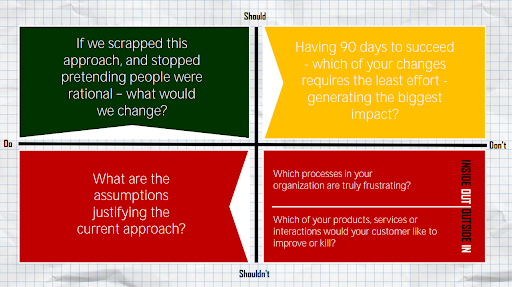Business Growth 2022: 9 life lessons from Shark Tank’s Barbara Corcoran
As the year wraps up and businesses prepare for 2023, leaders across Vistage gathered for a day of learning that kicked off with famed entrepreneur and Shark Tank executive producer Barbara Corcoran and concluded with author and influencer Martin Lindstrom sharing his framework for making decisions that are most connected to the customer.
Corcoran shares tips for leading and growing
 Barbara’s insights were lauded by attendees as inspirational and motivational. After sharing poignant stories that spanned from her childhood to present-day success, Barbara shared nine lessons that she has learned throughout her life, adding tips on how anyone can apply them to their leadership journey.
Barbara’s insights were lauded by attendees as inspirational and motivational. After sharing poignant stories that spanned from her childhood to present-day success, Barbara shared nine lessons that she has learned throughout her life, adding tips on how anyone can apply them to their leadership journey.
1. Perception creates reality.
Barbara advised leaders to believe in the power of third-party endorsement. As one attendee recapped, “YES! ‘Dream the painting, then paint the dream.’ Couldn’t agree more.”
2. Social media is the modern-day billboard.
If you follow Barbara on any of her social media channels, you’ll notice how prolific she is with sharing content as well as following trends. Her advice is to hire someone to do social media, someone who understands it well, and set them free. With a limitless audience, social media is essential to building a successful business today.
3. Balance your staff with expanders and containers.
Barbara firmly believes that you need both kinds of people working for your business. “When you can find the right people, you can hire and build faster,” she shared. Her model for building high-performing teams includes “matching leaders who are the opposite and they will soar.” As one respondent noted, “I love having the vocabulary for expanders and containers. Great framework.”
4. Hire happy people.
Happiness is infectious and boosts morale. The foundation of this sentiment is culture — hire those that contribute to a positive environment and remove those that detract. This leads to her next lesson…
5. Fire complainers.
Complainers bring negative energy and Barbara advised to think of them as thieves stealing optimism, energy and momentum. She likes to “fire people on Fridays,” which is advice she shares on her social channels, as well.
6. Exercise resilience: the most common trait of entrepreneurs.
While there are a lot of traits of top performers, the defining factor according to Barbara is that entrepreneurs keep getting up again “like a jack in the box.” Whether you call it resilience, tenacity or adaptability, those are the most demonstrated characteristics of successful entrepreneurs.
7. Fun is good for business.
If you want to create a company, you must create fun. The more absurd the fun, the greater the team you’ll build.
8. Recognition is more important than money.
With so many businesses offering increased wages to compete in today’s labor market, don’t underestimate the power that recognition can have to motivate others. Observe your employees, their personalities will highlight how they will be the most successful in your company.
9. The biggest successes happen on the heels of failure.
Take advantage of bad times to gain momentum, because according to Barbara “in bad times all the big guys go into hiding…they don’t want to lose what they already have.” Exercise those traits of resilience and adaptability as “the little guys have the corner on creativity” in bad times. In many of the stories she shared, Barbara noted that her biggest successes happened on the heels of failure, fueled by her ability to bounce back with a creative approach.
Following Corcoran, subject matter experts shared their expertise in breakouts on the topics of hiring, financials and wellness, which are available for viewing for Vistage members.
Part of the day’s events featured perspectives from Member Excellence Award winners. In a moderated discussion, Vistage Leadership Award winner Adam Hilton and Vistage Impact Award Winner Elissa Sangster shared in-depth views of how they drove growth in their companies.
Hilton drove impressive market share growth by innovating how his company, Engineered Corrosion Solutions, went to market to set it apart from the competition. Meanwhile, Sangster grew the Forté Foundation through the pandemic by successfully pivoting to delivering virtual content and tapping into how they can help companies find qualified women in a tight labor market.
Lindstrom: Take a ‘human-to-human’ approach to business
 The final keynote of the day was best-selling author and innovation expert Martin Lindstrom, who spoke about the importance of the customer and the blending of the B2B and B2C environments into an H2H (human-to-human) business approach. His thoughts complimented Barbara’s, especially the idea to “celebrate the successes of your organization. It will send a signal of hope throughout and inspire your team.”
The final keynote of the day was best-selling author and innovation expert Martin Lindstrom, who spoke about the importance of the customer and the blending of the B2B and B2C environments into an H2H (human-to-human) business approach. His thoughts complimented Barbara’s, especially the idea to “celebrate the successes of your organization. It will send a signal of hope throughout and inspire your team.”
Lindstrom shared his unique framework for how to approach innovation with the four questions leaders should ask themselves:
- If we scrapped this approach and stopped pretending people were rational, what would we change?
- What are the assumptions justifying the current approach?
- Having 90 days to succeed, which of your changes requires the least effort and generates the biggest impact?
- Inside out: Which processes in your organization are truly frustrating?/Outside in: Which of your products, services or interactions would your customer like to
improve or kill?

Other key takeaways he spoke about in regard to innovation and a customer-first approach included:
- Consider the issues — internally and externally — that are holding you back from connecting with your customers. Identify how you can remove these issues to gain a better connection with customers.
- When you grow and scale, you see the world from the inside out and lose common sense. Viewing the world from the outside in, you rely on empathy, and empathy equals common sense. The better you are at empathy the more common sense you’ll have and be able to connect with your customers.
- Small data is better than big data. The best ideas come from personal experiences. Have employees observe the customers in their environment and then come together to discuss the issues discovered and create solutions together.
- Anxiety is a deep emotional driver. Identify the anxiety you want to remove first. Provide alternative solutions to those concerns, and you’ll be able to create greater improvements.
Related Resources
Growth Stage Entrepreneur Resource Center
Category : Business Growth & Strategy

